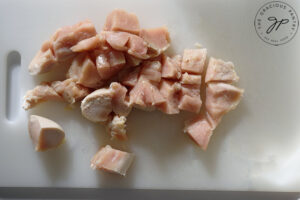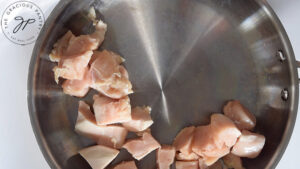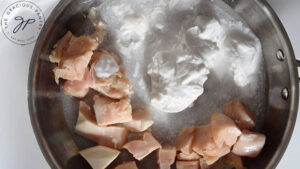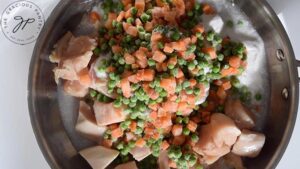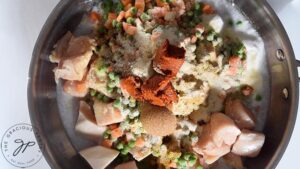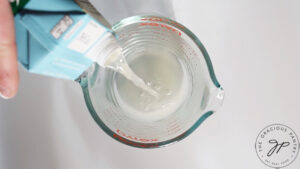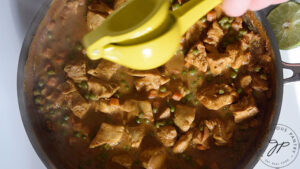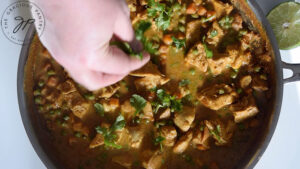Coconut Curry Chicken Recipe
Coconut Curry Chicken is always welcome in our home, and when you can make it quickly and easily, it makes it even better!
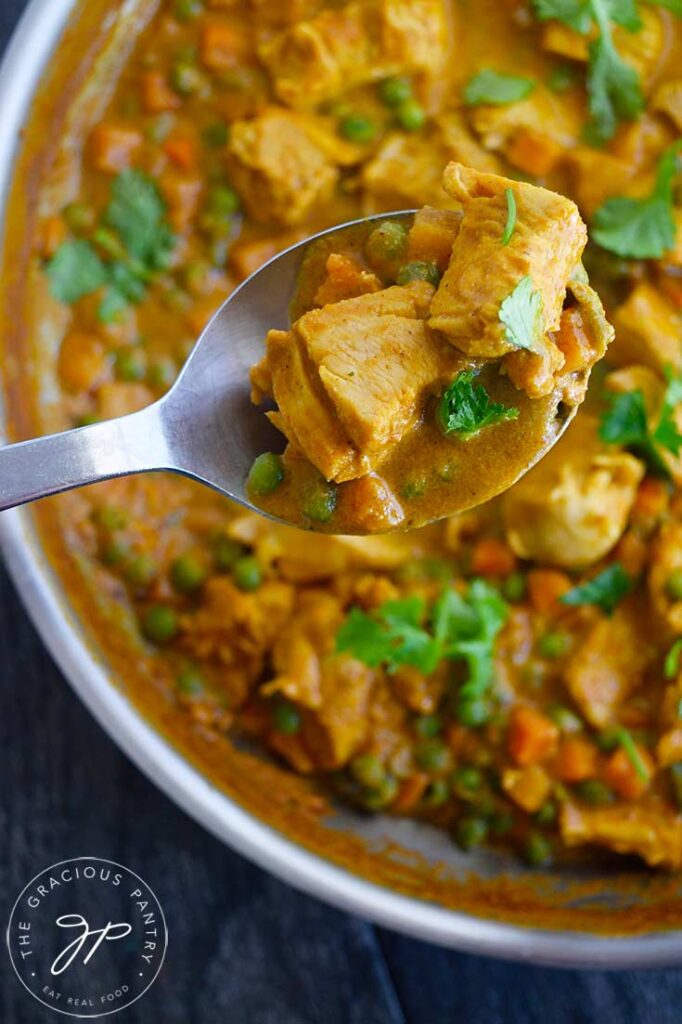
What Is Curry?
Curry is typically served as a meat and vegetable dish that has plenty of sauce (curry sauce) that is made with various Indian spices. The meats and vegetables can vary from recipe to recipe, as can the spices, which are typically dependent on the area of India it’s made in.
What Is Coconut Curry Chicken?
Coconut curry chicken is simply a specific type of curry. It can be made in either Thai or Indian flavors, but its primary ingredients are coconut milk-based sauce and chicken. This particular recipe calls for peas for the veggies. But you can use others if you prefer them.
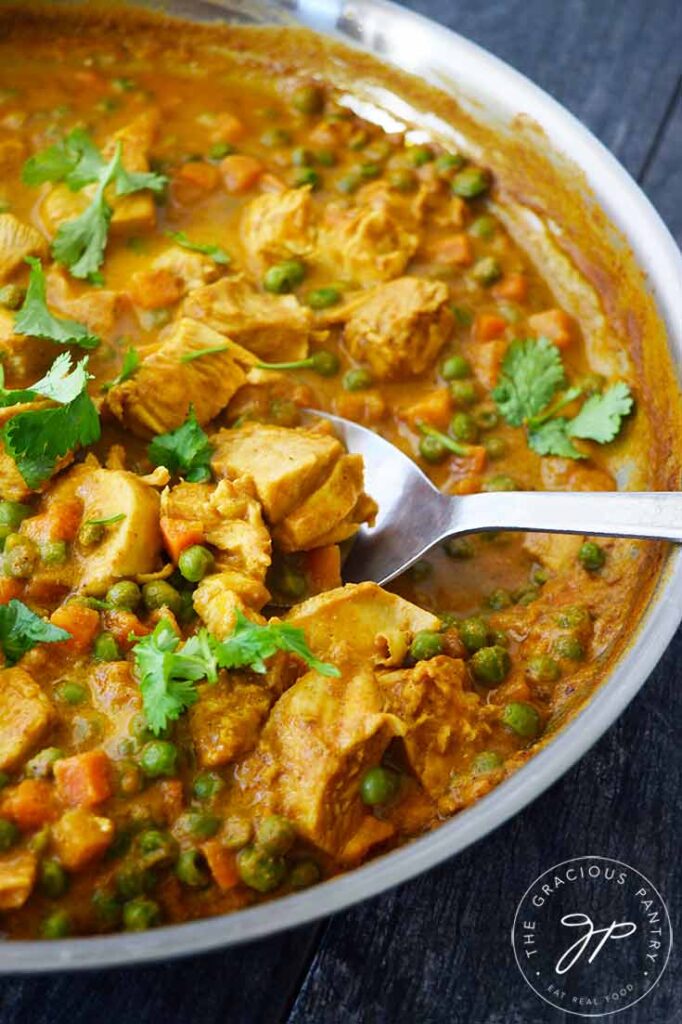
Coconut Curry Chicken FAQs
Where Is Coconut Curry Chicken From?
This is a Thai dish, through and through. Though the curry sauce can be made to be heavier in Indian flavors, its origins are in Thailand.
Are Coconut Curries Healthy?
That all depends on what you consider to be healthy. This dish is made with all-natural, whole-food ingredients, but it’s also higher in fat, due to the coconut milk.
Do I Use Coconut Milk Or Cream For Curry?
You can use either. But only use coconut cream if your sauce has plenty of other liquids. Otherwise, full-fat coconut milk tends to work the best.
Does Coconut Curry Taste Like Coconut?
While the coconut offers underlying tones, the major flavors in this dish are all about the spices. The spices and coconut milk work quite well together and create a nice balance in this sauce.
What Can I Use Instead Of Coconut Milk In Curry?
You can use full-fat milk or even heavy cream if you prefer that. Consider how creamy you want this dish to be, and use the corresponding milk accordingly.
Does Coconut Milk Thicken Curry?
Yes, but only in that, it adds extra creaminess from the fat content. If you truly wish to thicken a curry sauce, you could easily stir in starch, such as arrowroot or cornstarch. But if your curry is made well, it shouldn’t need it. It should be naturally thick enough.
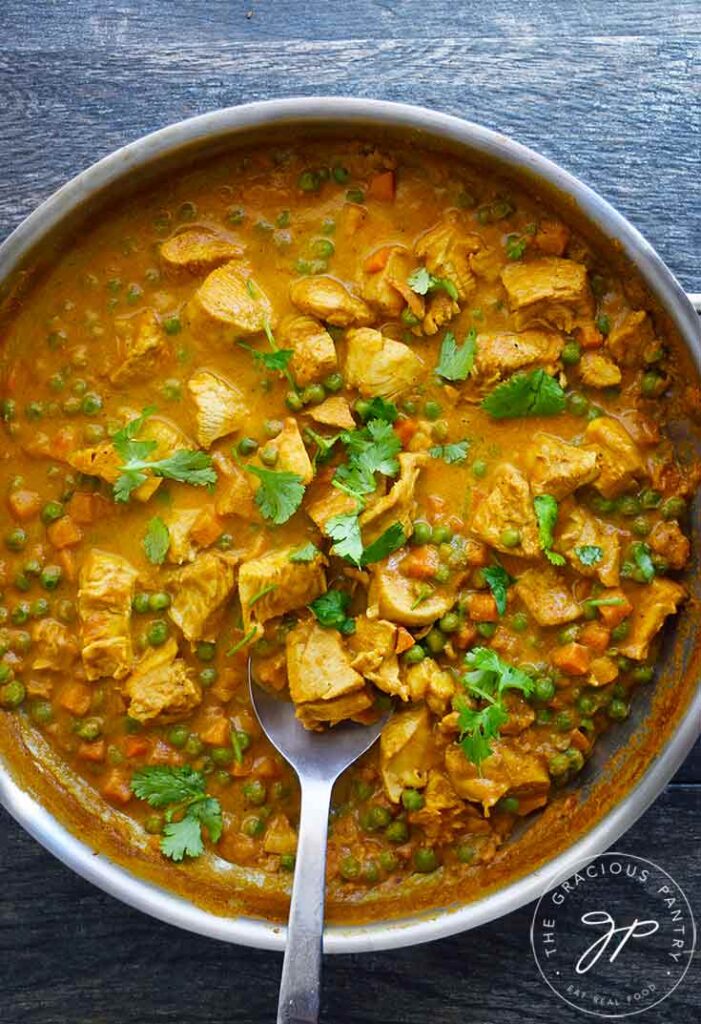
What Is Coconut Curry Made Of?
Chicken breasts – Cut into stew-sized pieces. You can use chicken thighs if you prefer them.
Canned full-fat coconut milk – You can use light coconut milk if you want to reduce the fat content, but the sauce won’t be anywhere near as creamy.
Frozen peas and carrots – You can buy them separately, or combined. Mine was a combined package.
Curry powder
Garam masala
Ground coriander
Garlic powder – If you prefer fresh garlic cloves, finely minced 1 tbsp.
Onion powder – If you prefer fresh onion, finely dice ½ a cup of red onion.
Ground ginger – If you prefer fresh ginger, finely minced 1 tsp.
Red curry paste – I used the Thai Kitchen brand. (Not paid to promote. It’s just what I use.)
Granular sweetener – Try Sucanat, coconut sugar, or monk fruit. I used brown erythritol because that’s what works best for my blood sugar.
Chicken broth – No sugar added (usually called dextrose in meat-based broths.) This is optional if you need to either thing your sauce or increase the amount of it. I added it to mine, but some may prefer a thicker sauce.
Salt and pepper – To taste at serving.
Optional Additions
- Fresh Spinach – Stir in fresh spinach leaves in the last 30 seconds of cooking. Stir until they wilt.
- Chopped tomatoes – Add about 1½ cups chopped tomatoes.
- Red Chilies – If you really like spice, add about a ⅛ to ¼ tsp. dry, ground chilies.
- Red pepper flakes – Another option for making things spicier.
- Tomato paste – If you want more tomato flavor, stir in 1 to 2 tablespoons.
- Cumin – If you want more of an Indian flavor, add 1 tbsp. ground cumin.
- Turmeric – If you love the health benefits of turmeric, you can stir in about 1 teaspoon.
How To Make Coconut Curry Chicken
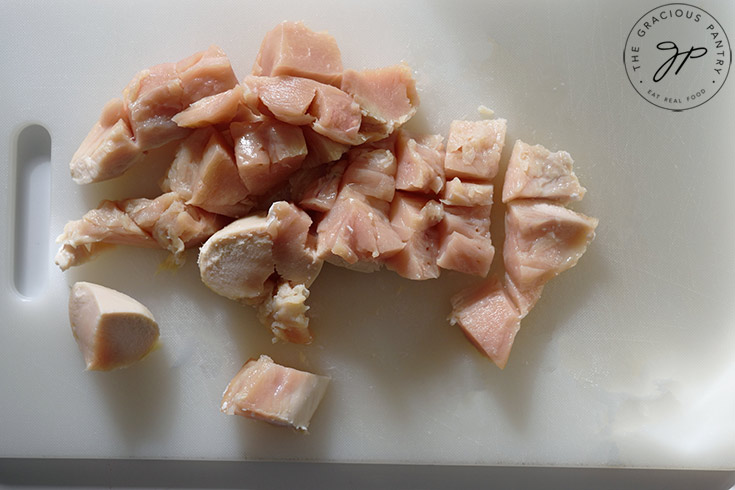
Prep
Cut the chicken into smaller, stew-sized pieces.
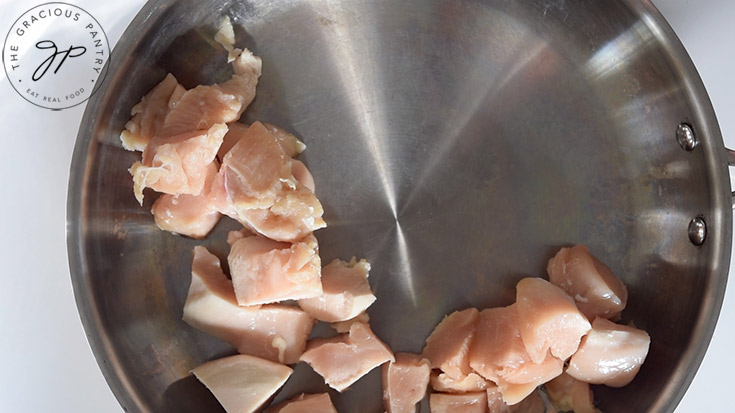
Add
Add the chicken to a large, dry skillet.
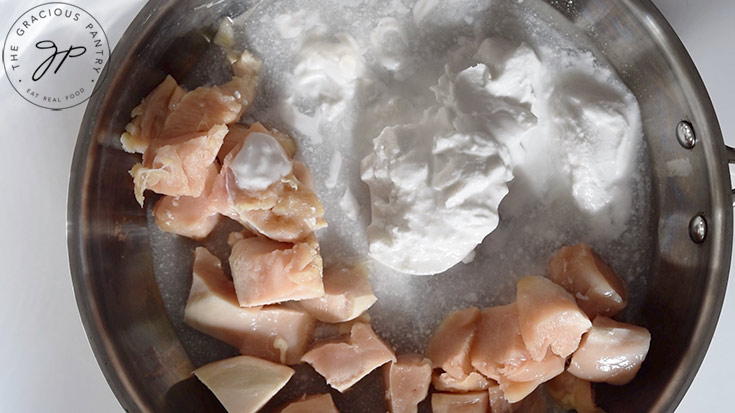
Pour
Pour the coconut milk into the skillet with the chicken.
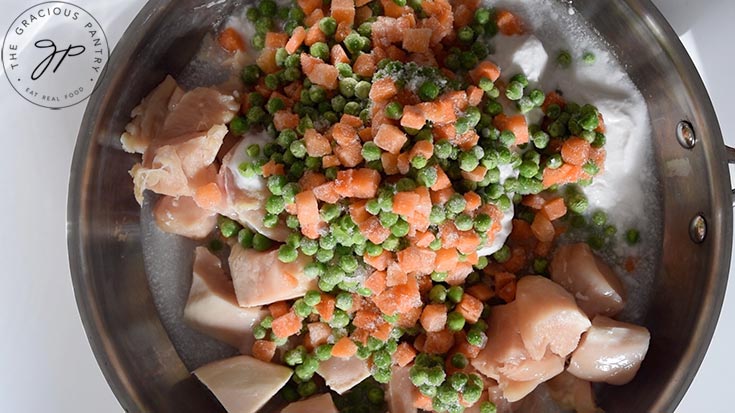
Top
Top the chicken and coconut milk with frozen peas and carrots.
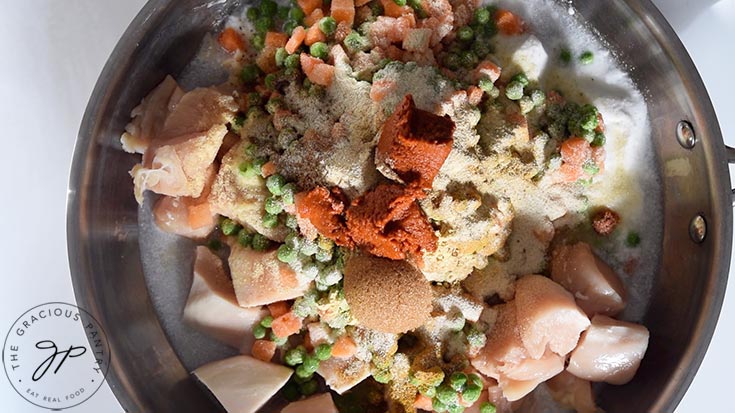
Season
Add all the remaining seasonings, including the curry paste and the sweetener.
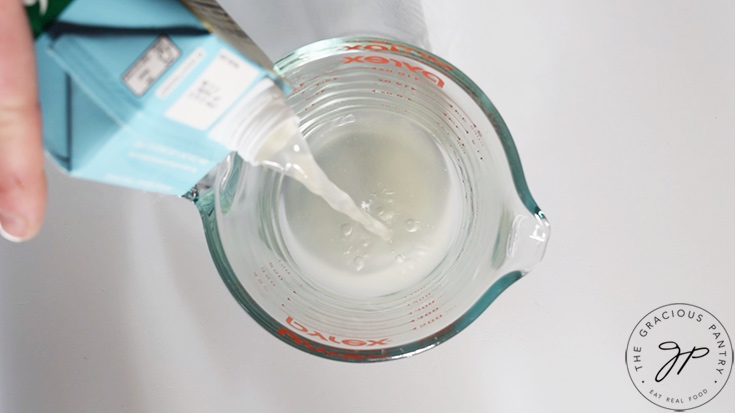
Cook
Sauté everything, stirring constantly, over medium-high heat, (keep it at a strong simmer) until the chicken is fully cooked through. It should be at least 165 F. on a meat thermometer. If needed for extra broth, add up to a ½ cup of chicken broth.
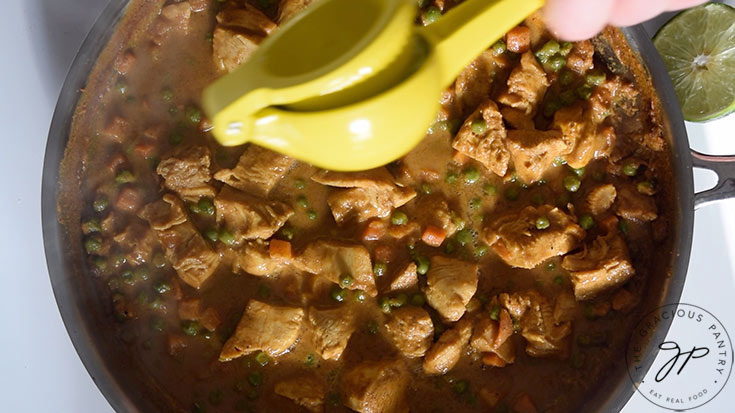
Squeeze
Squeeze fresh lime juice (about half a lime) over the finished dish.
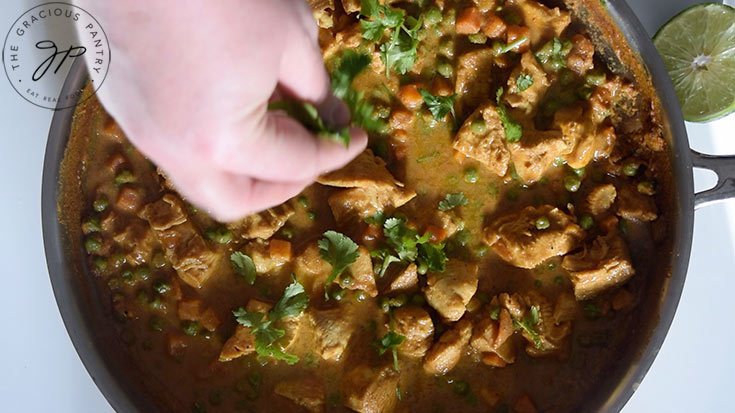
Garnish
Sprinkle chopped, fresh, cilantro over the top (optional). If you don’t like cilantro, chopped cashews are a good alternative for a garnish.
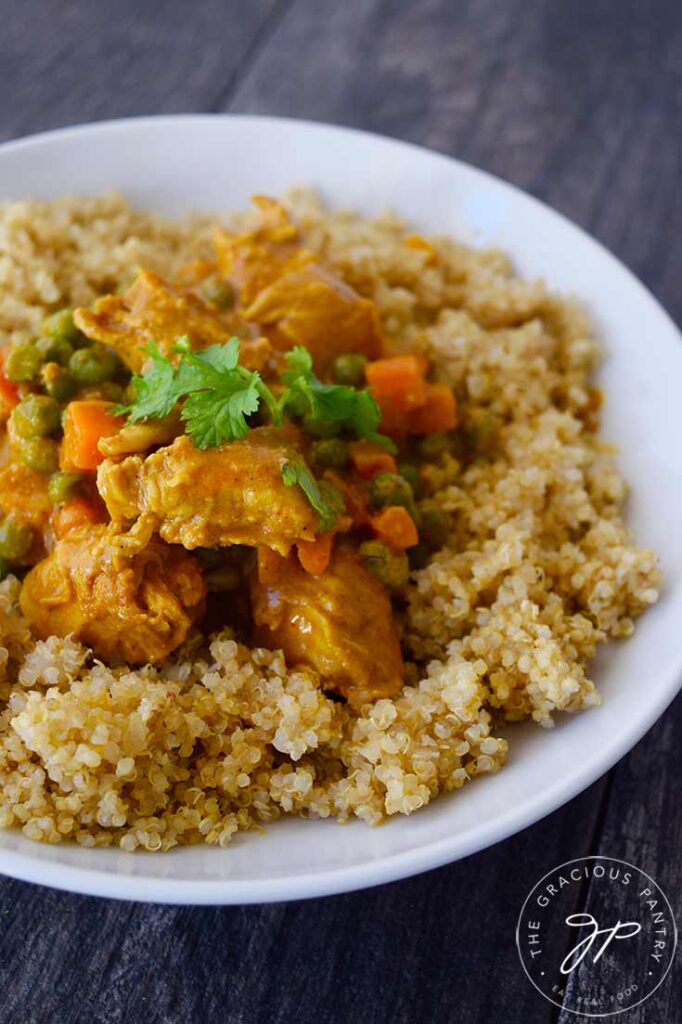
How To Store Coconut Curry Chicken
This should be kept in an airtight container in the fridge. If stored properly, it will last for up to 3 days in the fridge.
Can You Freeze Coconut Curry Chicken?
Definitely! This freezes quite well, actually. It’s great for stocking your freezer with healthy meals. My suggestion is to freeze it in single servings. It just makes life easier when you need a quick meal. Souper Cubes are also a great way to freeze this in portioned sizes. I use them all the time so I know exactly how much I’m eating every time.
What To Serve With Coconut Curry Chicken
This is most often served with rice. But aside from that, you can try serving this over a baked potato, a baked sweet potato, noodles, cauliflower rice, quinoa, or even over some toast or naan. It’s also quite good over other grains such as quinoa or millet.
Recipe Supplies
More Curry Recipes
SUBSCRIBE
Remember to subscribe to my free newsletter to receive all my latest recipes in your inbox. Click here to sign up!
Coconut Curry Chicken Recipe Card + Video

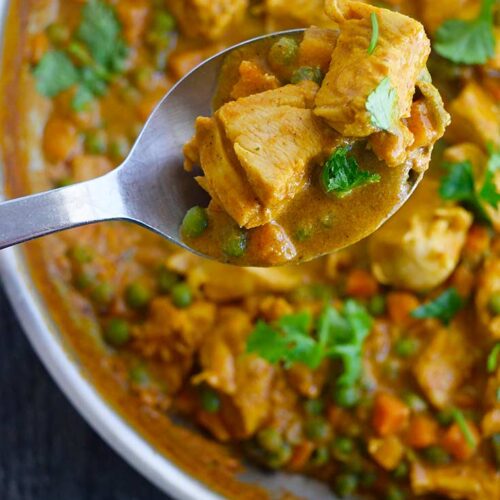
Coconut Curry Chicken Recipe
CLICK TO WATCH THIS RECIPE IN ACTION!
Equipment
- 1 Large Skillet
Ingredients
- 2.5 lb. boneless, skinless chicken breasts (cut into stew-size pieced)
- 14 oz. can full-fat coconut milk
- 10 oz. package frozen peas and carrots
- 1 tbsp. curry powder
- 1 tsp. garam masala
- 1 tsp. ground coriander
- 2 tsp. garlic powder
- 2 tsp. onion powder
- ½ tsp. ground ginger
- 2 tbsp. red curry paste (I used the Thai Kitchen brand)
- 1 tbsp. granular sweetener (such as Sucanat, coconut sugar or monk fruit)
- ½ cup chicken broth (no sugar/dextrose added)
Instructions
- Cut the chicken into smaller, stew-sized pieces.

- Add the chicken to a large, dry skillet.

- Pour the coconut milk into the skillet with the chicken.

- Top the chicken and coconut milk with frozen peas and carrots.

- Add all the remaining seasonings, including the curry paste and the sweetener.

- Sauté everything, stirring constantly, over medium to high heat, until the chicken is fully cooked through. It should be at least 165 F. on a meat thermometer. If needed for extra broth, add ¼ to a ½ cup of chicken broth.

- Squeeze half a fresh lime over the finished dish.

- Garnish with fresh, chopped, cilantro.

Nutrition
Original Recipe
The recipe below underwent quite an upgrade with the above version. While it doesn’t really even come close to the original, I thought I would post the original inspirational recipe from back when I first started eating clean and posting my recipes on this site. At least one person has emailed me for it, so I’m guessing there may still be a few people who enjoy the original recipe. Here it is.
Clean Eating Curry Chicken With Peas
(Makes 4 servings)
Ingredients:
- 2 large chicken breasts
- ½ (14 ounce can) light coconut milk
- ¼ cup chicken broth
- ½ package frozen peas
- ½ tablespoon mild curry powder
- ½ teaspoon garam masala
- ½ teaspoon garlic powder
Directions:
- In a large pot, combine all ingredients except the chicken, and bring to a soft boil.
- Add chicken breasts and boil until chicken is cooked through.
- If your sauce has not cooked down enough (it should cook down by almost half) by the time your chicken is cooked and you want the sauce to be thicker, you can add 2 tbsp. of organic corn starch to the pot to help thicken up the sauce.





